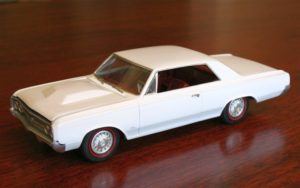Miniature models of automobiles began to pop up shortly after the first cars were introduced in the early 20th century. They were originally developed, not as toys for children or as models for hobbyists, but as promotional tools and design aids for car dealerships. These promos, made with the permission of the automakers in exact detail by companies such as A.M.T., JoHann, PMC and Hubley, were 1/25-scale versions that salesmen would use to show off to prospective customers. Car dealers did not always carry in stock every color option available, so the 1/25-scale replicas provided a way to show the prospective customer the car in their chosen paint color.

Sometimes the automakers would make special requests, such as adding working suspension on the wheels or hoods that could open to reveal engine details. As salesmen’s samples, these models proved to be a great way to demonstrate features to prospective customers. It was common practice in the late 19th and early 20th century to produce scaled-down, highly-detailed versions of things like furniture and appliances that a salesman couldn’t fit into their briefcase to show customers and retailers, so cars naturally followed.
Originally cast in metal, plastic took over in the 1950s, and the models were often very intricate, including trim, emblems and precise dashboard details to reflect the actual car. Not only did these promos provide prospects with a detailed look at what they might be buying, but they proved to be useful diversions for curious children while the salesmen worked out a deal with their parents. While it was at the request of car manufacturers that these promo models be made, some of the modelers went on to offer commercial versions for sale in retail stores.
Enservio Select was requested to determine the retail replacement value of two claimed items described by the claimant as a 1964 and a 1966 model Oldsmobile Toronado plastic car with no documentation. The 1950s’ promo models were frequently made of a plastic that tended to warp. In the 1960s, promo models were introduced with non-warping plastic bodies, though many of these cars did not survive the hands of playful children, as these two did.
The claimant stated there were only 10 of these model cars in the world and assigned a claimed value of $25,000 for each car. However, they were unable to provide any supporting documentation to lend weight to such a high valuation.
Enservio Select reviewed a total of 33 images of the model cars documenting all the necessary details to provide an accurate evaluation. Review of the provided images confirmed the make and model of the claimed 1966 Oldsmobile Toronado dealer promotional model car in “Silver Mist” paint. The actual Oldsmobile Toronado was a personal luxury car produced by the Oldsmobile division of General Motors from 1966 to 1992.
The second model was described by the claimant to be a 1964 Oldsmobile Toronado, though our research determined it to actually be a 1964 Oldsmobile Cutlass 2-door hardtop dealer promotional model car in “Nocturne Mist” paint. The Oldsmobile Cutlass was a line of automobiles produced by Oldsmobile between 1961 and 1988, and again briefly in 1997-1999. It was Oldsmobile’s smallest, entry-level product.
Throughout the course of our research of vintage comparable dealer promotional model cars of like, kind and quality (LKQ) available in the current retail marketplace, and in review of recent realized auction sales, Enservio Select determined $130 to be a reasonable vintage retail replacement value for the 1966 Oldsmobile Toronado dealer promotional model car in “Silver Mist” paint. As for the 1964 Oldsmobile Cutlass 2-Door hardtop dealer promotional model car, $250 was determined to be a reasonable vintage retail replacement value – 100 times less than the original claimed amount, as supported by examples available in the retail market.
Ryan Paveza is an Antiques & Collectibles specialist for Enservio (www.enservio.com), a provider of contents claim management software, payments solutions, inventory and valuation services for property insurers. Paveza worked at the Art Institute of Chicago as a Collection Manager and Research Assistant for seven years. He is a member of the American Society of Appraisers (ASA) and has passed the Uniform Standards of Professional Appraisal Practice (USPAP).
Was this article valuable?
Here are more articles you may enjoy.

 Hermès Heir Sues Arnault and LVMH in $16 Billion Suit Over Lost Shares
Hermès Heir Sues Arnault and LVMH in $16 Billion Suit Over Lost Shares  Thailand’s Record Floods Paralyze Key Hubs for Tech and Car Parts
Thailand’s Record Floods Paralyze Key Hubs for Tech and Car Parts  ‘Dream Is in Sight:’ Chamber, Reinsurers, Insurers Urge Florida to Stay the Course
‘Dream Is in Sight:’ Chamber, Reinsurers, Insurers Urge Florida to Stay the Course  Atmospheric River to Flood Pacific Northwest Through Week
Atmospheric River to Flood Pacific Northwest Through Week 